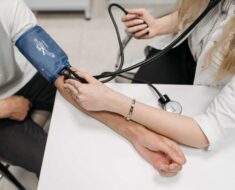
When the state of Michigan expanded its Medicaid program to provide health coverage to more low-income residents, its leaders built special features into the plan, different from most states. They wanted to encourage enrollees to understand their individual health risks, and incentivize them to prevent future health problems, or find them early.
According to two new studies, that effort has paid off.
The percentage of enrollees in the Healthy Michigan Plan who saw a primary care doctor in a given year doubled, and many of those visits included a discussion of healthy behaviors that could improve their long-term health, the studies show.
Half of the enrollees said they completed the Healthy Michigan Plan “health risk assessment” questionnaire and went over it with a physician. A majority of enrollees got preventive care, such as cancer screenings or dental visits.
It appears that the special financial incentives that the state built into the program played only a partial role in completion of the health risk assessment. In fact, many of the enrollees didn’t even know they could get a cost-sharing discount by filling it out and discussing it with their doctor.
The new findings appear in two papers published in the Journal of General Internal Medicine by several members of the Healthy Michigan Plan evaluation team from the University of Michigan Institute for Healthcare Policy and Innovation.
A focus on primary care and prevention
The studies are based on results from a survey of more than 4,000 Michiganders, out of the more than 1 million who have gotten coverage from the Healthy Michigan Plan since its launch in 2014.
The program currently covers more than 642,000 state residents who make less than about $16,000 a year for an individual, or $33,000 for a family of four. Among those surveyed, over two-thirds are working, going to school, retired or unable to work.
“Customizing Medicaid expansion to emphasize primary care and prevention took extra effort, but appears successful, at least according to the snapshot of enrollees that these data represent,” says Susan Dorr Goold, M.D., MHSA, M.A., the lead author of one of the two papers and a professor of internal medicine at U-M.
Former IHPI National Clinician Scholar Taylor Kelley, M.D., M.P.H., M.Sc., now at the University of Utah, notes, “While too early to tell whether the program will lead to sustained behavior change, it is clear more conversations are happening between doctors and patients about lifestyle change, and patients have been surprisingly eager to commit to healthy behaviors.” Kelley is lead author of the other of the two papers.
“The role of primary care providers, and their teams, in helping low-income and working-poor people understand what health risks they face, and encouraging them to modify the risk factors they can change, is crucial,” says Renuka Tipirneni, M.D., M.Sc., senior author of the paper led by Kelley and an assistant professor of internal medicine.
Goold, Kelley, Tipirneni and many of their co-authors have been part of the IHPI team that is carrying out the official evaluation of the Healthy Michigan Plan for the Michigan Department of Health and Human Services.
The team surveyed 4,090 HMP participants between the ages of 19 and 64 years who had been enrolled in the program for more than a year, using their preferred language of English, Spanish, or Arabic. The survey was carried out in 2016, and claims data were also used to examine enrollees’ use of health care services.
Some of their key findings:
Insurance status:
- Nearly 58% of those surveyed had not had health insurance in the year before they enrolled in HMP, and half of the rest said they had previously had insurance through Medicaid or another state program.
- One-third said they hadn’t gotten care they needed in the 12 months before enrolling, mostly because of cost or a lack of insurance coverage. Nearly two-thirds of this subgroup said they’d gone without dental care they needed.
- Nearly 90% said that having HMP coverage had reduced their stress and worry; those who had been uninsured before they obtained HMP coverage were even more likely to say so.
Where they received care:
- One in five enrollees said they hadn’t had a primary care visit in the five years before their HMP coverage began, and only two-fifths had seen a primary care provider in the year before they enrolled in HMP coverage.
- Nearly 90% of enrollees had seen a primary care provider since enrolling, and nearly 95% of those enrollees said they had discussed wellness and prevention as part of a primary care visit.
- Ninety-two percent said that they now had a regular source of medical care, compared to under 73% before they were covered by HMP.
- The percentage who said that their regular source of care was an emergency room or urgent care center dropped from 25.3% before enrollment, to 7% after they enrolled in HMP.
- Getting covered didn’t automatically mean access to care: 15% said that despite their HMP coverage, they had still gone without needed care in the past 12 months, for varied reasons including costs and their health plan’s coverage provisions.
- 59% said their HMP coverage had helped them get access to prescription drugs, and 46% said it had helped them get access to dental care.
Health risk assessments
- Half of enrollees said they had completed a health risk assessment, or HRA.
- Nearly four-fifths of those who completed an HRA chose to work on a healthy behavior, and the percentage was even higher among those with chronic illnesses. More than half of them chose to work on eating healthier and/or exercising more.
- Nearly a fifth of those who chose a healthy behavior to work on said they would try to stop smoking, that percentage was even higher among those with a mental health condition or substance use disorder.
- Only 31.5% of enrollees said that completing the HRA hadn’t been helpful because they already knew what they needed to do to improve their health.
- Nearly half of those who completed an HRA said they did it because their primary care provider had encouraged it. Only 2.5% said that the promise of a monetary reward spurred them to complete an HRA, and only 28% said they had known that they could get a reduction in the amount they would have to pay.
Preventive health care
- More than 70% of the women over 50 had received breast cancer screening in the past 12 months under HMP, and more than half of adults over 50 had received colon cancer screening. Cancer screenings, and other proven preventive screenings and vaccinations, are covered by the Healthy Michigan Plan with no co-pay.
- Sixty percent of enrollees had seen a dentist in the past year through their HMP coverage.
- More than 10% of enrollees who reported using tobacco had gotten a prescription for an FDA-approved product to help them break their nicotine habit.
- Those who knew that preventive health services were available at no cost to them were more likely to receive them. But knowledge that completing an HRA could reduce their fees didn’t increase use.
Source: Read Full Article





